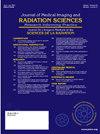Bolus:组织等效,但它们是等效的吗?
IF 2
Q3 RADIOLOGY, NUCLEAR MEDICINE & MEDICAL IMAGING
Journal of Medical Imaging and Radiation Sciences
Pub Date : 2025-05-01
DOI:10.1016/j.jmir.2025.101936
引用次数: 0
摘要
目的/AimBolus是控制不规则轮廓和浅表疾病部位(如头颈部疾病部位)辐射剂量的重要工具。Bolus是由不同癌症中心和疾病部位的不同材料制成的。根据它们的密度和表面吸收剂量的能力,它们被确定为“组织等效”材料。辐射束在一定深度达到其“最大剂量”,这取决于能量,因为它们在沉积最大剂量之前需要一个积聚区域。将药丸放在皮肤表面会产生一个“假”积聚区域,这意味着最大剂量会沉积在皮肤表面。本研究的目的是比较PLA(聚乳酸长丝)和凡士林/石油纱布丸在定位、材料因素和密度上的差异是否真正等同。方法/工艺本研究通过测量PLA(聚乳酸长丝)3d打印丸剂与凡士林/石油纱布丸剂对头颈部患者计划剂量的准确性及分数间变化进行比较。在参与患者治疗的连续3-4天,使用放置在丸下的tld(热发光探测器)以cGy测量皮肤剂量。对每位患者的测量数据进行分析,并对每个队列进行比较。结果或益处/挑战平均而言,两种剂量的准确性与计划剂量相当,但在观察每位患者的cbct和剂量定位后,每种材料都存在独特的挑战。凡士林丸的再现性比3D要好,可能是由于在丸上浇铸并保持它的位置。3d打印的厚度比凡士林更均匀,但在热塑性铸件上的定位存在气隙和定位误差,影响了其再现性。结论/影响总体而言,这两种材料在治疗中都是可接受的,但在改进3D丸定位方面仍有待改进,因此它将真正为患者定制,并确定最适合每个头颈部部位的轮廓。本文章由计算机程序翻译,如有差异,请以英文原文为准。
Bolus: Tissue Equivalent, But are They Equivalent?
Purpose/Aim
Bolus is a crucial tool in manipulating radiation dose for disease sites with irregular contours and superficial disease, such as the head and neck disease site. Bolus is made with varied materials across different cancer centers and disease sites. They are determined as “tissue-equivalent” materials based on their density and ability to pull dose superficially. Radiation beams reach their “maximum dose” at a certain depth, depending on energy, because they require a build-up region before depositing their maximum dose. Placing bolus on top of the skin creates a “false” build-up region, meaning maximum dose will be deposited at the skin surface. The purpose of this study is to compare whether PLA (polylactic acid filament) and Vaseline/petroleum gauze bolus are true equivalents considering their difference in positioning, material factors and density.
Methods/Process
This study compares PLA (polylactic acid filament) 3D-printed bolus and Vaseline/petroleum gauze bolus on head and neck patients through measuring their accuracy to the planned dose and their inter-fraction variation. Dose to skin was measured in cGy on 3-4 consecutive days of the participating patients’ treatments using a TLDs (thermolumiscent detectors) placed underneath the bolus. The measurements of each patient were analyzed each cohort was compared.
Results or Benefits/Challenges
Both boluses had, on average, equivalent accuracy to the planned dose but upon observing CBCTs and bolus positioning with each patient, there were challenges unique to each material. Vaseline bolus’ reproducibility was better than that of 3D, possibly due to the cast being molded over the bolus and keeping it in place. 3D-printed had more uniform thickness than Vaseline but the positioning over the thermoplastic cast presented air gaps and positioning errors that affected its reproducibility.
Conclusions/Impact
Overall, both materials were acceptable for treatment but strides can be taken to improve 3D bolus positioning so it will truly be customized to the patient and what contours are most appropriate for each head and neck site.
求助全文
通过发布文献求助,成功后即可免费获取论文全文。
去求助
来源期刊

Journal of Medical Imaging and Radiation Sciences
RADIOLOGY, NUCLEAR MEDICINE & MEDICAL IMAGING-
CiteScore
2.30
自引率
11.10%
发文量
231
审稿时长
53 days
期刊介绍:
Journal of Medical Imaging and Radiation Sciences is the official peer-reviewed journal of the Canadian Association of Medical Radiation Technologists. This journal is published four times a year and is circulated to approximately 11,000 medical radiation technologists, libraries and radiology departments throughout Canada, the United States and overseas. The Journal publishes articles on recent research, new technology and techniques, professional practices, technologists viewpoints as well as relevant book reviews.
 求助内容:
求助内容: 应助结果提醒方式:
应助结果提醒方式:


